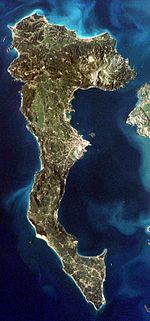Corfu Incident
| Corfu Incident | |||||||
|---|---|---|---|---|---|---|---|
 Corfu, one of the Ionian Islands |
|||||||
|
|||||||
| Belligerents | |||||||
|
|
|
||||||
| Commanders and leaders | |||||||
|
|
|||||||
| Strength | |||||||
|
2 or 3 battleships |
150 (the Greek garrison) | ||||||
| Casualties and losses | |||||||
| none | 16 civilians killed, 30 injured and 2 amputated or 20 civilians killed and 32 wounded. |
||||||
|
|
|||||||
2 or 3 battleships
2 or 4 cruisers
5 or 6 destroyers
2 Torpedo boats
4 MAS boats
2 submarines
1 airship
airplanes
6 batteries of light artillery
The Corfu Incident was a 1923 diplomatic and military crisis between the Kingdom of Greece and the Kingdom of Italy.
There was a boundary dispute between Greece and Albania. The two nations took their dispute to the Conference of Ambassadors, which created a commission of British, French, and Italian officials to determine the boundary, which was authorized by the League of Nations to settle the dispute. The Italian General Enrico Tellini became the chairman of the commission. From the outset of the negotiations, the relations between Greece and the commission were negative. Eventually the Greek delegate openly accused Tellini of working in favour of Albania's claims.
On August 27, 1923 the Italian general Enrico Tellini, two of his aides, their interpreter and a chauffeur fell into an ambush and were assassinated by unknown assailants at the border crossing of Kakavia, which is near the town of Ioannina, within Greek territory. The five victims were Enrico Tellini, Major Luigi Corti, Lieutenant Mario Bonacini, Albanian interpreter Thanassi Gheziri and the chauffeur Farnetti Remizio. None of the victims were robbed. The incident occurred close to the disputed border and therefore could have been carried out by either side.
According to Italian newspapers and the official statement of the Albanian government, the attack was carried out by Greeks, while other sources, including the Greek government and its officials and the Romanian consul in Ioannina, attributed the murder to Albanian bandits. Also, Reginald Leeper, the British ambassador at Athens on 1945, in a letter to the British Foreign Secretary at April 1945 mention that the Greeks can blame Cham Albanians for the murder of General Tellini.
...
Wikipedia

